Inverloch - Dinosaur Dreaming Dig Site

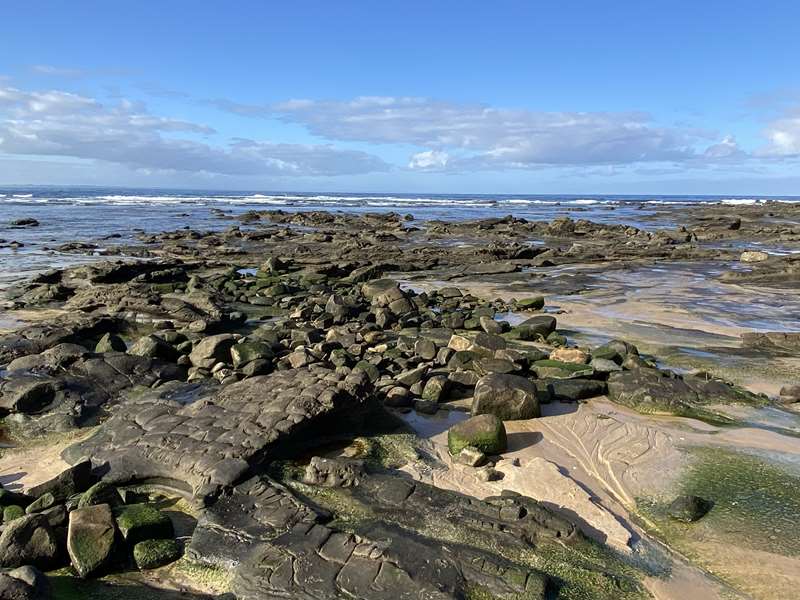
Travel back in time 126 million years at Inverloch's Dinosaur Dreaming dig site and take a walk in the footprints of the dinosaurs.
More than 15,000 bones, teeth and fossils of small dinosaurs have been found at The Caves beach, just out of Inverloch on the rugged Bunurong coastline. All of the items date back to about 126 million years.
How to Experience the Site
- Plan your visit at low tide. When the tide is out, an extensive rock platform is exposed, revealing rock pools and imprints that tell a prehistoric story.
- Look out for the dinosaur footprint (see directions below).
- From the car park, make your way down the beach track and read about the dinosaurs that once ruled this section of the earth on a series of interpretation board.
- Guided tours to the dig site run over holiday periods or custom visits for groups can be arranged through the Bunurong Environment Centre. Begin with an introduction to dinosaur fossils and the geological history of the region, then learn to spot tell-tale signs of fossil presence and do your own search. Tours are suitable for school-aged children and older.
From Inverloch, head west towards Cape Paterson on the Cape Paterson-Inverloch Road. Turn left into The Caves Car Park immediately after Flat Rocks. The drive takes 8 minutes from Inverloch town centre.
Location of Dinosaur Footprint
This is what the dinosaur footprint looks like:
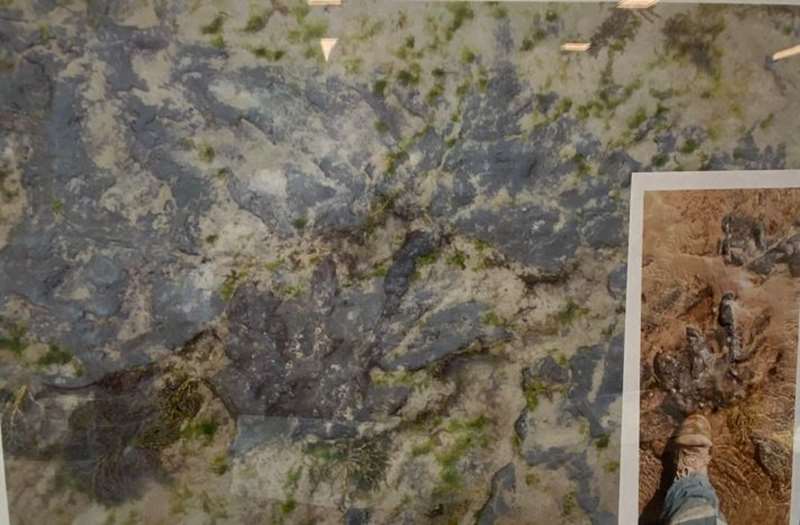
A dinosaur footprint is located about 100m north north-east of where the stairs from the car park meet the beach. It is located on a rock shelf and is only accessible at low tide.
Another way of finding the footprint is to look for this on the cliff face. The footprint is about 50m from the cliff.
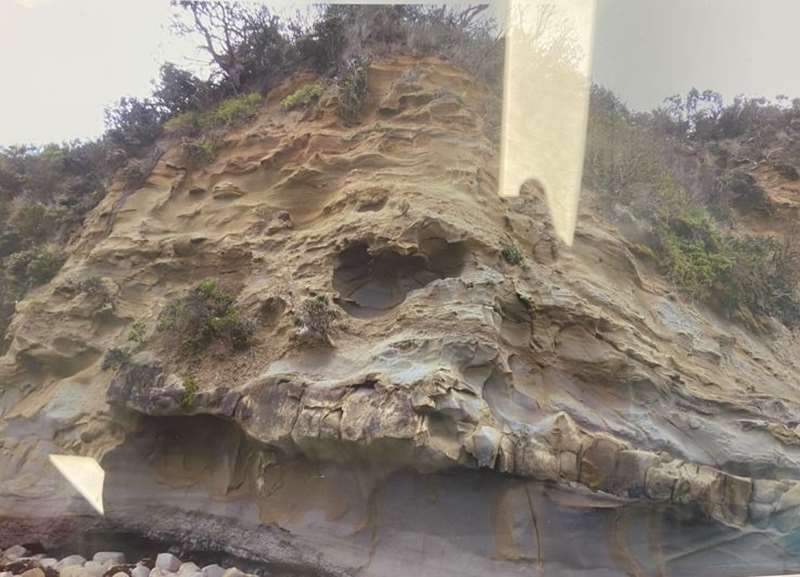
Swimming - It is not recommended to swim at The Caves beach due to strong currents, unexpected large waves and submerged objects (lots of rocks).
Cliffs - The cliffs are a high hazard zone. Beware of falling rocks and collapsing cliffs. Stay well away from the base of the cliff.
Camping, fires and removing shellfish is prohibited from the area.
Access for Dogs:
Dogs are not permitted on the beach 9am-6pm, 1st Dec to 14th Apr. On-leash at all other times.
Information Panels
The following information panels are located beside the path on the way down to the beach.
Imagine if you can....
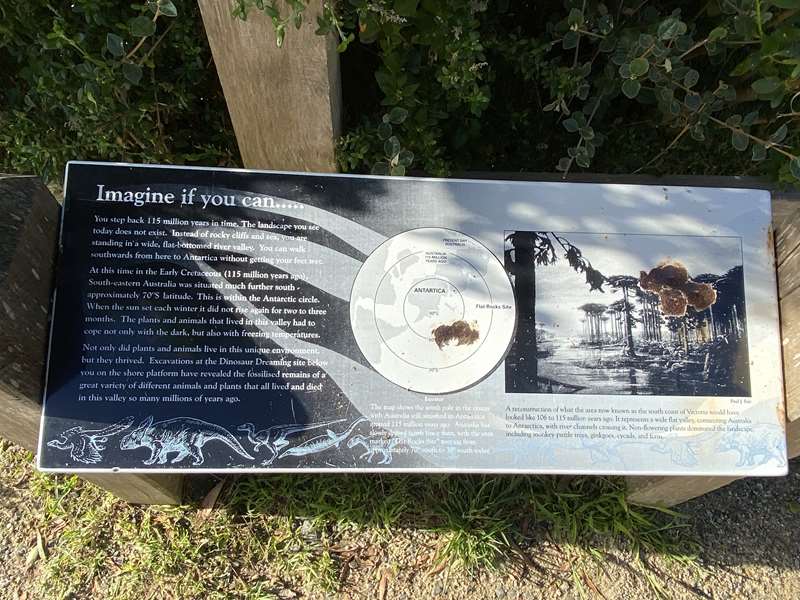
You step back 115 million years in time. The landscape you today does not exist. Instead of rocky cliffs and sea, you are standing in a wide, flat-bottomed river valley. You can walk southwards from here to Antarctica without getting your feet wet.
At this time in the Early Cretaceous (115 million years ago), South-eastern Australia was situated further south - approximately 70S latitude. This is within the Antarctic circle. When the sun set each winter it did not rise again for two to three months. The plants and animals that lived in this valley had to cope not only with the dark, but also with freezing temperatures.
Not only did plants and animals live in this unique environment but they thrived. Excavations at the Dinosaur Dreaming site below you on the shore platform have revealed the fossilised remains of a great variety of different animals and plants that all lived in this valley so many millions of years ago.
The Dig....
Since 1994, researchers from Monash University and Museum Victoria have conducted annual summer field trips in this area. The main site is situated on the shore platform below you. As the richest part of the fossil layer is in the intertidal zone, the site is only accessible 3-4 hours either side of low tide. An average of 1000 fossil bones and teeth of animals that lived and died in the rift valley are painstakingly collected each field season.
The Dinosaur Dreaming dig operates under a National Parks permit and is the only working dinosaur dig in Victoria. It is illegal to remove rocks, fossils, or living organisms from this site without a permit and large fines apply.
The work involves digging out the sand that accumulates in the excavations during each high tide. Once the fossil rock has been removed from the site it must be carefully broken down, using a hammer and chisel, to pieces the size of a sugar cube. Every broken surface of rock is carefully examined in the hope of finding a tiny. tooth or bone. All volunteers are extensively trained to recognise what fossil bone looks like before they are allowed to touch the rock. The crew is made up of volunteers from all walks of life - many come to this site from other countries to help us find these precious bones. Once the fossils are found, they must be professionally conserved, or they crumble away to dust in a few years.
Dinosaurs....
The fossilised remains of many different dinosaurs have been discovered along this coastline, but most of them have only been identified from single bones and teeth.
The most common dinosaur bones belong to herbivorous (or plant-eating) dinosaurs: hypsilophodontids and ankylosaurs. Small dinosaurs like Qantassaurus intrepidus, lived in and around the forests along the edge of the rivers. Tiny bones of baby dinosaurs have been recovered from the Dinosaur Dreaming site below you, as well as the bones of many adult animals.
Much rarer, but perhaps more exciting, are the fossil teeth and bones of carnivorous (or meat-eating) dinosaurs. Some species had hollow, fragile bones that did not fossilise as well as the more sturdy plant-eaters. Many single teeth from small meat-eating dinosaurs, similar to Velociraptor, have been found here, as well as the fossil hones of larger predatory dinosaurs, similar to Allosaurus.
Not just dinosaurs....
Dinosaurs were not the only animals to inhabit this amazing landscape. We are digging up the remains of an ancient river, the most common fossils we find belong to the animals that lived in the water, such as primitive turtles, giant labyrinthodont amphibians and different species of fish. The isolated teeth of small fresh water plesiosaurs have also been found. Flying animals such as birds and pteroaurs are also represented in this fauna.
In March 1997 the first evidence of tiny mammals was discovered - 16mm long jaw - which propelled this site to world prominence. All the Mesozoic mammal remains throughout the world would fit into a shoe box, that is how rare they are. So far at least six different types of tiny mammals the size of a mouse have been discovered at the Dinosaur Dreaming site.
The Dinosaur Dreaming project is an ongoing research program, and we all look forward to the exciting discoveries that lie ahead, which will shed new light on Australia's past.
Review:
This is a wonderful place to explore for those with an interest in dinosaurs and especially for those with an active imagination. Even though more than 15,000 bones, teeth and fossils of small dinosaurs have been found here, the chances of a casual visitor finding a fossil are very small. However, you could find the dinosaur footprint with patience and luck. Your imagination runs wild here with rocks appearing to be shapes of huge dinosaurs (although are actually aren't!).
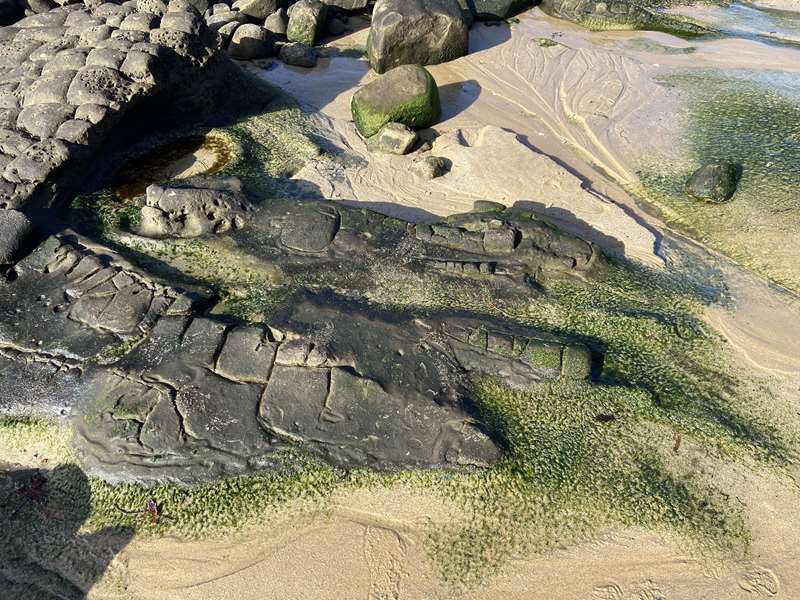
Photos:
Location
The Caves Car Park, Cape Paterson-Inverloch Road, Inverloch 3996 Map
Web Links
→ Tide Predictions for Victoria
→ Melbourne Tide Times (Tides Chart)









